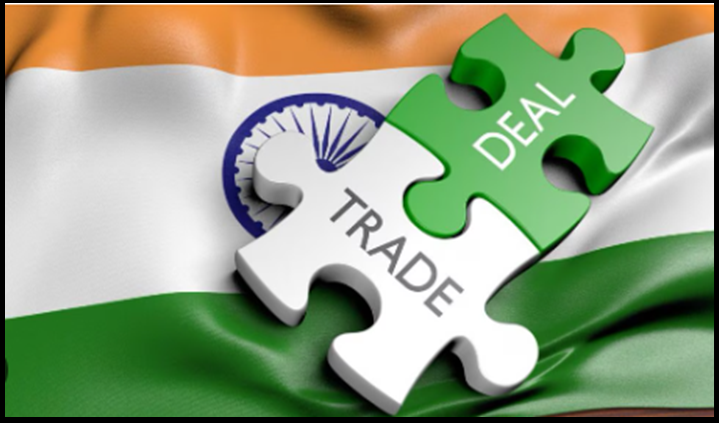EMBRACING GREEN TRADE: INDIA’S STRATEGIC SHIFT IN FTAS
Syllabus:
- GS-2- Trade and Commerce with countries, FTA , Autonomy and its impact on economy and society
Focus :
- The article discusses India’s strategic shift towards incorporating sustainability in its trade agreements, highlighted by the recent trade and economic partnership agreement with the European Free Trade Association (EFTA). It underscores the need for India to integrate non-trade issues like environmental standards, labor, and gender rights into FTAs to align with global practices and enhance trade opportunities.
Source - TET
Introduction
- Recent Agreement: India’s recent Trade and Economic Partnership Agreement (TEPA) with the European Free Trade Association (EFTA) marks a significant step towards integrating non-trade issues in trade agreements.
- Innovative Features: The agreement includes chapters linking potential investment with tariff liberalization and a comprehensive chapter on trade and sustainable development.
- Shift in Approach: This move reflects India’s preparedness to take extra steps to build preferential trade frameworks with developed regions like the EU and North America.
India’s Evolving Trade Strategy
- Reluctance Fading: Historically, India avoided including non-trade issues in FTAs, but the TEPA shows a shift in this approach.
- Investment Cooperation: The chapter on investment cooperation signals India’s need for investments and its readiness to go the extra mile.
- Open Economy Targets: For an open economy, diverse instruments are necessary to achieve various targets, reflecting Jagdish Bhagwati’s concept of separating environmental and trade policies.
- Advanced Nations’ Strategy: Developed countries have integrated non-trade issues in FTAs as instruments for growth objectives, which sometimes camouflage protectionist intents.
Key Points of the India-UAE FTA
|
Determinants for Non-Trade Issues in FTAs
- Economic Policy Alignment: India’s economic policies must align with its ambition to become a developed country by 2047.
- Ineffectiveness of WTO: With WTO likely to be ineffective in the near term, FTAs become crucial tools for trade and industry policy.
- Multilateral Agreements: India, a signatory to many multilateral environmental agreements, labor, and gender-related conventions, should conform to its obligations.
- Geopolitical Dynamics: Emerging geopolitical dynamics and forward policy actions position India advantageously for trade expansion.
Trade and Sustainable Development
- Market Leverage: India’s vast market of middle-class buyers offers leverage for trade expansion.
- Calibration of Obligations: India can calibrate the pace at which it adopts obligations related to sustainability, aligning with its development goals.
- Interlinked Issues: The argument that trade should remain separate from issues like the environment and labor is no longer tenable.
- Differentiated Responsibility: Developing countries should emphasize differentiated responsibility and address the lack of physical and financial capacities in negotiations.
Enforceability of Non-Trade Issues
- Templates for Enforcement: Present-generation FTAs have three enforceability templates—expressing understanding, using consultation, and enforcing obligations through dispute-settlement systems.
- Incremental Approach: India should adopt an incremental approach that safeguards its long-term economic objectives while reassuring trading partners.
- SDG Goals: Aligning FTA commitments with Sustainable Development Goals (SDGs) ensures that trade agreements support India’s development agenda.
- Avoid Contradictions: Avoid commitments that contradict the fundamentals of the multilateral trade regime, ensuring compliance with international norms.
Leveraging Financial and Technological Commitments
- Performance-Based Obligations: The extent to which India moves up the value chain of obligations should depend on the financial and technological commitments of potential trading partners.
- Innovative Commitments: Innovative commitments, such as recognizing developing-country rights to priority use of carbon space and joint carbon trading initiatives, can be integrated into FTAs.
- Long-Term Development: These innovative ways ensure the trade partner’s involvement in the long-term development of green trade.
- Swift Decision-Making: The faster India decides, innovates, and prepares for integrating green elements in trade agreements, the better for its trade and development prospects.
Conclusion
- Unavoidable Green Trade: It’s challenging to avoid trade agreements with green elements, making it essential for India to adapt quickly.
- Strategic Shift: India’s strategic shift towards integrating sustainability in FTAs aligns with global practices and enhances its trade opportunities.
- Future Prospects: By embracing green trade, India can position itself advantageously in the global trade landscape and achieve its long-term economic and developmental goals.
Source:The Economic Times
Associated Article :
https://universalinstitutions.com/investment-lessons-from-the-india-efta-trade-deal/
Mains Practice Question :
GS-2
“Discuss the significance of incorporating non-trade issues like environmental standards, labor, and gender rights into India’s Free Trade Agreements (FTAs). How can India leverage its market and geopolitical position to enhance trade opportunities while aligning with global sustainability practices?”(250 words)




